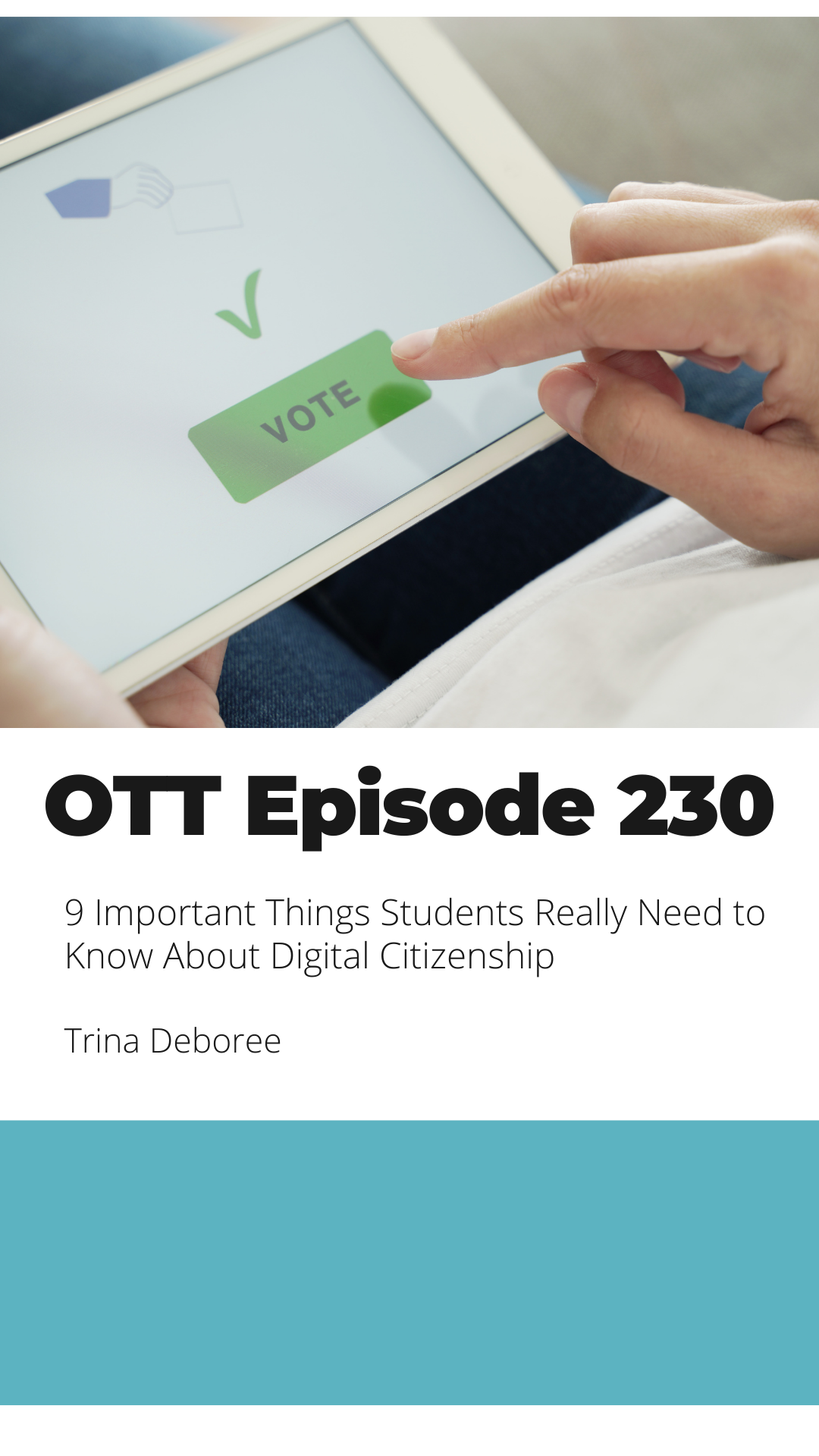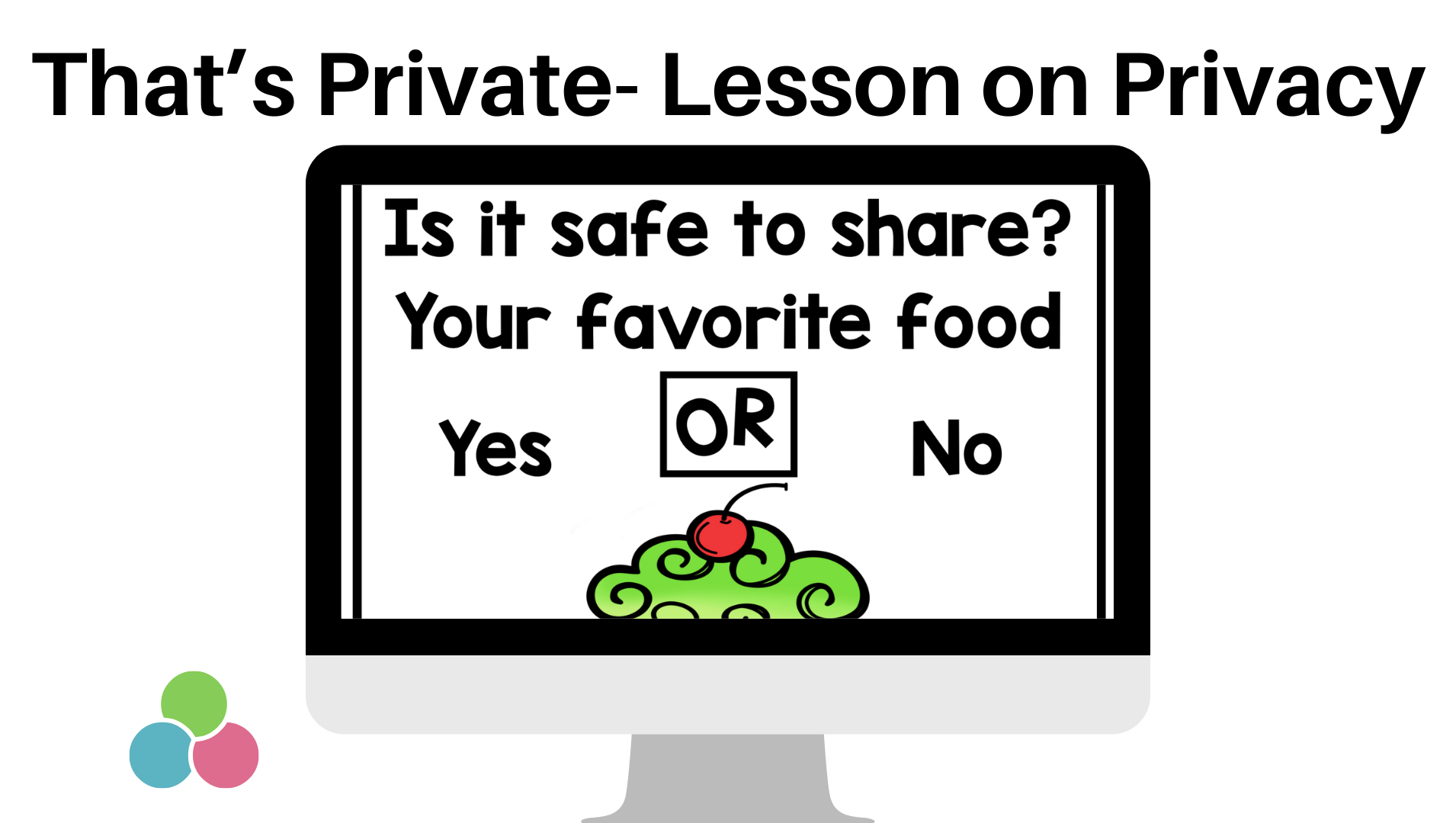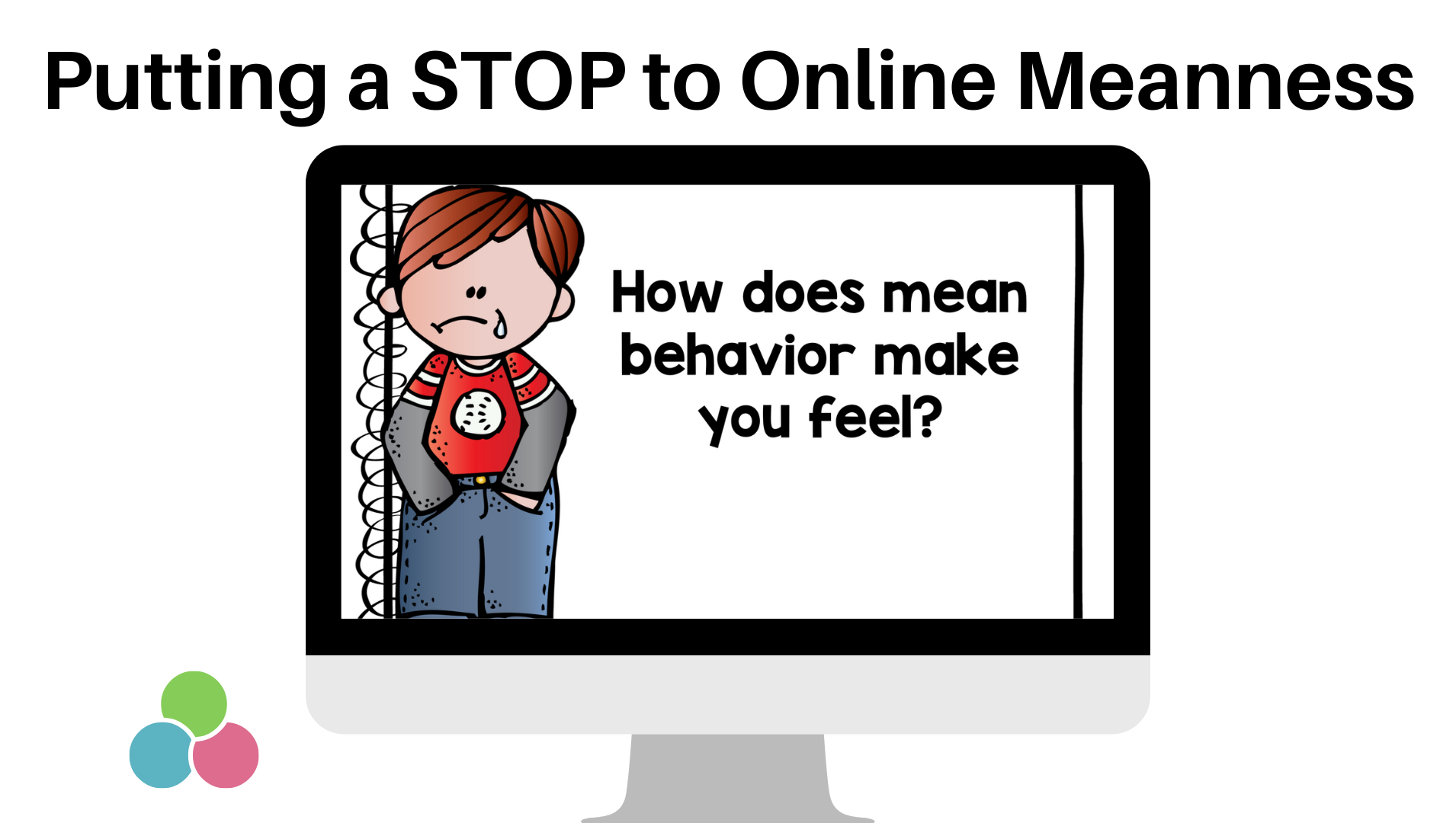OTT 230: 9 Important Things Students Really Need to Know About Digital Citizenship
In this digital age where cat videos and viral challenges reign supreme, it's easy to forget that there is more to being an online citizen than just knowing how to double-tap on Instagram.
Yes, my dear friend, it's time we talk about digital citizenship skills and digital citizenship in a digital world – a concept that goes beyond posting selfies and clever hashtags on social media. So grab your virtual thinking caps and prepare to level up your digital literacy skills because, in this post/podcast, we'll unravel nine crucial things you really need to know about navigating the vast terrain of online communities like a true cyber-savvy pro. Buckle up, folks; it's going to be one wild (and educational) ride!
The Importance of Digital Citizenship Education in the Real World
Digital citizenship education is often overlooked, but it plays a vital role in preparing students for the modern world, and as school leaders, it is our responsibility to ensure our students are prepared for the real world and the virtual world. Sure, we can teach them addition and subtraction and the main idea, but do they know how to navigate the treacherous waters of social media? Do they understand the consequences of their online actions? Digital citizenship education equips students with the skills and knowledge to engage in our digital society responsibly. Digital citizenship should be covered in grades K-12.
One of the crucial elements of digital citizenship is understanding the concept of privacy. In an era where sharing personal information has become as natural as breathing, it's essential for students to learn about safeguarding their online presence. They should be aware that once something is shared on the internet, it might live forever in cyberspace – a haunting reminder from their past that could come back to haunt them in future job interviews or college admissions. I know that's so hard to imagine when teaching a first or second-grader, but it all still matters in the lives of all kids.
Furthermore, digital citizenship education also emphasizes responsible behavior. Students need to learn about cyberbullying and its effects on mental health. They must be taught empathy and kindness towards others, even behind a screen. Understanding that everyone they encounter online is a real person with feelings could prevent them from participating in harmful behaviors and foster more positive virtual interactions in elementary school and for the rest of their lives.
So, let us not underestimate the importance of digital citizenship education. It goes beyond just teaching kids how to use technology; it empowers them to make informed choices online and cultivate safe digital communities while fostering good digital citizenship.
The Importance of Device-Free Moments
We live in a digital age where our devices have become an extension of ourselves, and even our students rely heavily on them. Students rely on them for communication, information, entertainment, and sometimes even validation, which can be a major struggle for their mental health. But amidst this constant connectivity and digital noise, it is crucial to create device-free moments for children that allow them to reconnect with themselves and the world around them.
When we teach kids to detach from their screens, we give them the freedom to think independently and cultivate their own voice. Without the distractions of YouTube and TikTok, we can truly allow our students to focus on their own thoughts, ideas, and beliefs without external influence. It is during these device-free moments that we can teach children to tap into their creativity and nurture their own unique perspective on life.
Moreover, taking regular breaks from digital technology can significantly improve overall well-being. Constant exposure to screens has been linked to increased stress levels, decreased sleep quality, and even a decline in mental health. By consciously setting aside time away from devices, we are giving kids the opportunity to recharge mentally and emotionally, as well as fully focus on learning inside the classroom. These device-free moments not only enhance productivity but also offer a refreshing break for the mind.
To help teach children the value of device-free time, I have created a lesson and activity for second graders inside of my Digital Citizenship packet. Although I created this for 2nd grade as part of an overall plan for teaching digital citizenship, I believe it would work for several different grade levels. You can grab this lesson for free by clicking the button below.
Online Privacy: Protecting Personal Information Online and Freedom of Speech for Young People
With the rapid advancement of technology, it is crucial for children in elementary school to understand the significance of online privacy and freedom of speech. Teaching them about digital citizenship can help instill these values early on. However, explaining abstract concepts like personal information protection and free expression to young minds can be challenging. To make it relatable, parents and teachers can draw parallels between the online world and real life situations.
For instance, when discussing online safety and privacy, children can be encouraged to think about their own diaries or secret boxes where they keep their personal belongings safe from prying eyes. Similarly, just as they wouldn't share sensitive information with strangers on the playground, they should also avoid sharing such details with unknown individuals online. Teaching kids to make smart choices with their privacy can be one of the greatest lessons we teach kids. By emphasizing these connections between offline and online activities, children can better grasp the importance of safeguarding personal information.
Moreover, teaching kids about freedom of speech in a witty manner can also foster their understanding. One way to do this is by highlighting that while everyone has the right to express themselves freely, it does not mean that there are no consequences for what is said. Just as kids wouldn't shout inappropriate or hurtful things in a library or during a classroom discussion, they need to learn how to use their words in a responsible way, even on digital platforms. By equating internet interactions with everyday social scenarios that children encounter at school or home, we can empower them with valuable insights into being responsible digital citizens while allowing them to exercise their rights within appropriate boundaries.
If you would also like to teach this vital lesson of privacy, I cover That's Private! inside of my digital citizenship packet. You can click here to see all the grade levels I cover.
Digital Footprint: Managing and Controlling Online Presence With Digital Citizenship Lessons to Protect Private Information
In today's digital age, teaching elementary school students about responsible online behaviors is more crucial than ever. From sharing personal information to interacting with strangers, the virtual world can pose unforeseen risks. However, by integrating digital citizenship lessons into their curriculum, educators can support students in managing and controlling their online presence while protecting their private information.
By teaching children about the concept of a digital footprint, educators can empower them to take control of their online identities. Understanding that everything they do or share online leaves a trace can encourage students to think twice before posting or engaging in risky behaviors. Moreover, emphasizing the importance of privacy settings and the potential consequences of careless actions will equip them with the essential skills needed to navigate the digital realm responsibly.
One fresh perspective on this topic is shifting focus from fear-mongering tactics to fostering critical thinking skills. Instead of simply warning children about potential dangers lurking behind every click, providing opportunities for open discussions and encouraging questions can enable them to develop a deeper understanding of how their actions impact others in cyberspace. By nurturing an environment where students are encouraged to analyze scenarios and make informed decisions, we not only prepare them for digital life but also instill qualities necessary for becoming competent global citizens in any setting.
Overall, integrating digital citizenship lessons into elementary school curricula has become imperative in our technology-driven world. Many teachers choose Digital Citizenship Week as the time to teach digital citizenship. That can be great, but it is also important to discuss responsible digital citizenship all year long.
Online Etiquette: Practicing Good Manners in Digital Spaces to Be a Good Citizen
In today's digital age, where screens dominate our lives, it is crucial for elementary school students to learn about online etiquette and practice good manners in digital spaces. Teaching the responsible use of technology at a young age plays an important role in shaping these future citizens. After all, being a good citizen goes beyond just behaving nicely in the physical world; it extends into our online interactions as well.
One fresh insight to consider is that online spaces allow for anonymity, making it tempting for some to forget their manners. Reminding children that there are real people behind those usernames can help them understand the impact of their words and actions. A witty way to approach this topic could be by challenging them to imagine how they would feel if someone said something mean or disrespectful about them online - suddenly, the importance of kind words becomes crystal clear!
I cover Who Is In Your Virtual Community inside of my digital citizenship packets. You can grab this resource here.
Moreover, engaging children with new perspectives on online etiquette can be done by emphasizing the idea of building a positive digital footprint. Explaining that everything they say or do online leaves a lasting impression can encourage them to think twice before posting thoughtless comments or sharing inappropriate content. By equipping elementary students with these crucial skills and insights early on, we ensure that they grow up to become responsible digital citizens who understand the power of their presence in virtual spaces.
Cyberbullying: Understanding the Impact and How to Prevent It
In today's digital age, where children are growing up surrounded by technology, the concept of digital citizenship has become more crucial than ever before. One aspect of online behavior that demands our attention is cyberbullying, a pressing issue that affects elementary school students all too often. Not only can cyberbullying have devastating effects on an individual's mental and emotional well-being, but it can also have long-lasting consequences that spill over into adulthood.
To truly tackle the problem at its root and prevent cyberbullying from taking hold in elementary schools, it is essential to empower children with the tools and knowledge they need to develop an independent voice. Instead of just labeling certain behaviors as bad or wrong, we should encourage open discussions about empathy, kindness, and respect in both online and offline settings. By fostering a supportive environment where differences are celebrated rather than ridiculed, we give students the confidence to stand up against cyberbullying and promote positive interactions among their peers.
Preventing cyberbullying requires not only teaching children how to respond when they witness it but also arming them with the skills necessary to protect themselves from becoming victims. This includes educating students about privacy settings on social media platforms, highlighting best practices for passwords, and sharing personal information discreetly online. By incorporating these lessons into their daily routines early on, we help young learners navigate the intricacies of the digital world while equipping them with resilience against potential harm caused by cyber bullies.
I cover Putting a STOP to Online Meanness inside of my digital citizenship packets. You can grab this resource here.
Copyright and Plagiarism: Respecting Intellectual Property Rights
In today's digital world, teaching children about copyright and plagiarism is a necessity. With an abundance of information at their fingertips, it's important for elementary school students to understand the importance of respecting intellectual property rights. By instilling these values early on, we are setting them up to become responsible digital citizens in the 21st century.
But how do we make copyright and plagiarism engaging for young minds? One approach is to incorporate interactive activities and games into the curriculum. Rather than lecturing about the dos and don'ts of copying content, students can learn through play. For example, organizing a copyright detective game where they have to spot instances of unauthorized use can be both informative and entertaining.
Furthermore, it's crucial to teach kids how to cite their sources when using others' work responsibly and properly. Just as we stress the importance of writing our names on art projects or assignments, citing sources should become second nature, too. Encouraging creativity while fostering information literacy skills will not only help children gain a deeper understanding of copyright and plagiarism but also ensure that they navigate the digital landscape ethically and with confidence in their own abilities.
So let’s empower our little ones with knowledge about intellectual property rights—after all, they are the future innovators who will shape our world! By making copyright concepts tangible, exciting, and easy to grasp from an early age, we set them up for success in this 21st-century arena where originality thrives!
Media Literacy: Evaluating and Critically Analyzing Online Content
When it comes to online content, trustworthiness is key. In an era where fake news and misinformation abound, teaching elementary school students how to evaluate and critically analyze online information is crucial. By instilling media literacy skills at a young age, we can empower these digital natives to be discerning consumers of information.
One way to approach media literacy in the classroom is by introducing the concept of credibility clues. We can teach students to look for signs that indicate whether a website or article contains trustworthy information. For example, does the author provide credible sources? Is the website frequently updated? Are there grammatical errors or outlandish claims? Encouraging children to ask these questions fosters critical thinking skills while simultaneously enhancing their ability to distinguish reliable sources from unreliable ones.
Moreover, incorporating a witty tone into media literacy lessons can make the learning experience more engaging and memorable for students. Why not turn evaluating online content into an exciting detective game where children need to uncover clues about reliability? By infusing creativity into our teaching methods, we can ensure that kids remain motivated while gaining valuable skills that will serve them well throughout their lives as responsible digital citizens.
Conclusion: Empowering Students to be Responsible Digital Citizens
In conclusion, digital citizenship is not just a buzzword; it's an essential skill for every student in today's digital age. By understanding the importance of online privacy, practicing responsible social media usage, and being aware of the consequences of cyberbullying, students can navigate the digital world with confidence and integrity. Moreover, by honing their critical thinking skills and becoming savvy consumers of information online, students can protect themselves from misinformation and fake news. So, let's equip our students with these crucial skills and empower them to be responsible digital citizens.










